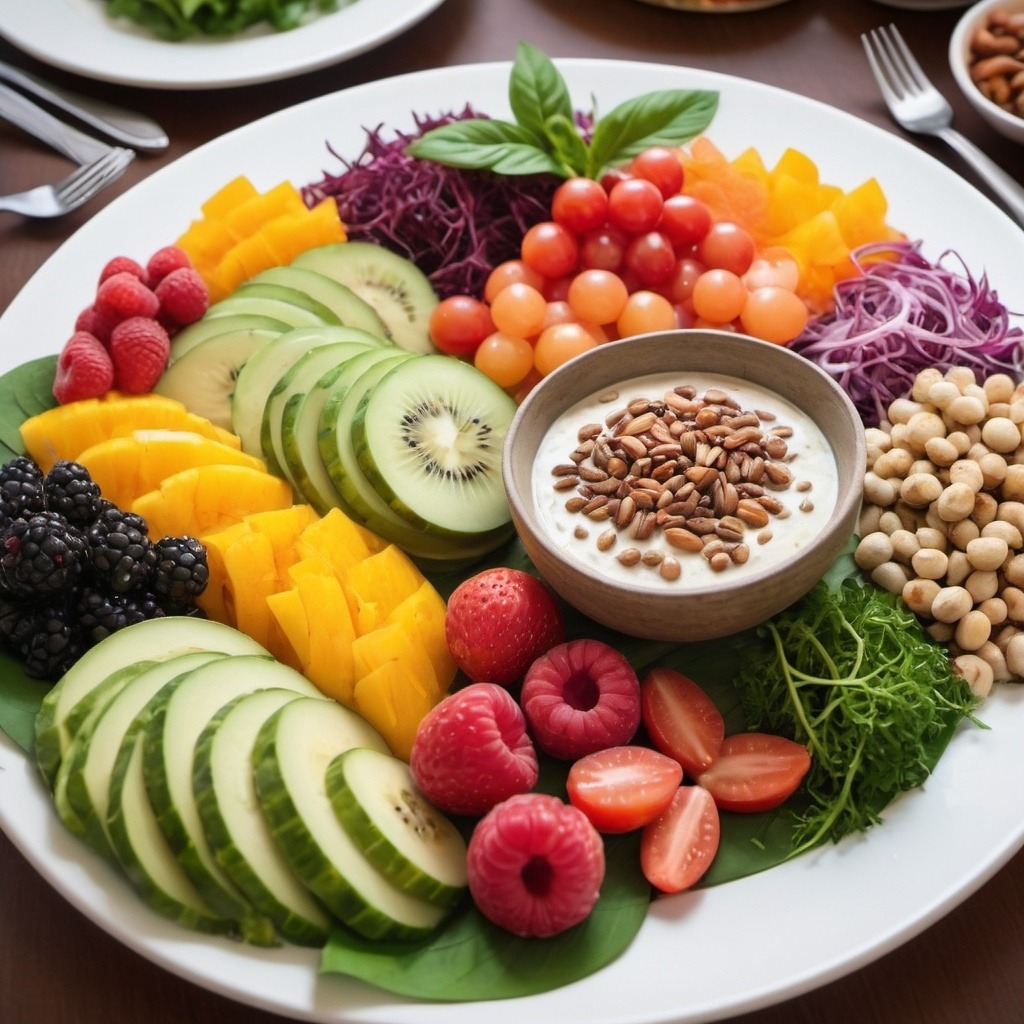
Managing diabetes effectively involves a holistic approach, with diet playing a central role. For those living with diabetes, understanding the intricacies of nutrition and how different foods impact blood sugar levels is crucial. Crafting a balanced meal plan tailored to individual needs can significantly enhance one’s quality of life and help maintain stable blood sugar levels.
Overview of Diabetes and the Importance of Diet
Diabetes is a chronic condition characterized by high blood sugar levels due to the body’s inability to produce or effectively use insulin. Type 1 diabetes typically involves an autoimmune response that destroys insulin-producing cells, while Type 2 diabetes is often related to lifestyle factors, including diet and physical activity.
Diet is a cornerstone of diabetes management. The foods you eat directly impact your blood sugar levels, and making informed choices can help prevent dangerous spikes and dips. A well-balanced diet ensures that the body gets the necessary nutrients without causing significant fluctuations in blood glucose levels. For more detailed information on the importance of diet in diabetes management, check out this comprehensive guide from the American Diabetes Association.
The Role of a Balanced Meal Plan in Managing Diabetes
A balanced meal plan is essential for managing diabetes. It involves selecting foods that provide steady energy, support overall health, and keep blood sugar levels within a target range. Key components of a balanced meal plan include:
- Macronutrients: Carbohydrates, proteins, and fats are the primary energy sources. Understanding how each affects blood sugar is crucial. For instance, carbohydrates have the most immediate impact on blood sugar, so choosing complex carbs with a low glycemic index is beneficial.
- Micronutrients: Vitamins and minerals are vital for bodily functions and overall health. Diabetics should ensure they get enough micronutrients through a varied diet.
- Fiber: High-fiber foods help regulate blood sugar levels and improve digestive health. Incorporating fruits, vegetables, whole grains, and legumes into meals can make a significant difference.
A structured meal plan helps in making consistent food choices that align with one’s health goals. It also aids in portion control, which is vital for managing diabetes. Regular meals and snacks prevent blood sugar levels from dropping too low, which can be as dangerous as high blood sugar levels.
By adhering to a balanced meal plan, individuals with diabetes can enjoy a variety of foods while keeping their condition under control. This approach not only supports physical health but also enhances overall well-being, providing a foundation for a healthier lifestyle. For additional insights on building a balanced meal plan, explore this resource from the Mayo Clinic.
Maintaining a balanced diet tailored to individual needs can significantly enhance one’s quality of life, demonstrating the profound impact of dietary choices in managing diabetes effectively.
Understanding Diabetic Nutritional Needs
For individuals with diabetes, understanding nutritional needs is paramount to effective management of the condition. By focusing on the right balance of macronutrients, micronutrients, fiber, and the glycemic index, one can craft a diet that supports stable blood sugar levels and overall health.
Macronutrients: Carbohydrates, Proteins, and Fats
Carbohydrates are the primary energy source for the body but have the most significant impact on blood sugar levels. Simple carbs found in sugary foods can cause rapid spikes in blood glucose, whereas complex carbs, such as those in whole grains, legumes, and vegetables, break down more slowly and lead to more stable blood sugar levels. It’s crucial for diabetics to monitor their carbohydrate intake and choose options with a low glycemic index to maintain steady glucose levels.
Proteins are essential for muscle repair and overall growth. They have a minimal impact on blood sugar levels, making them a vital component of a diabetic meal plan. Including lean protein sources such as poultry, fish, beans, and tofu can help manage hunger and maintain muscle mass without causing blood sugar fluctuations.
Fats play a critical role in providing energy and supporting cell function. However, the type of fat consumed is important. Unsaturated fats, found in nuts, seeds, avocados, and olive oil, are beneficial and can improve heart health, which is particularly important for individuals with diabetes who are at a higher risk for cardiovascular diseases. Saturated and trans fats, often found in processed foods, should be limited as they can increase the risk of heart disease and negatively affect blood sugar control.
Micronutrients: Vitamins and Minerals
Micronutrients, including vitamins and minerals, are essential for various bodily functions and overall health. Diabetics need to ensure they get an adequate amount of these nutrients to support their immune system, energy levels, and metabolic processes. For instance, Vitamin D is crucial for bone health and immune function, while Magnesium helps with glucose control and insulin sensitivity. A varied diet rich in colorful fruits, vegetables, lean proteins, and whole grains can help meet these micronutrient needs.
Importance of Fiber and Glycemic Index
Fiber is a type of carbohydrate that the body cannot digest, and it plays a significant role in managing diabetes. Soluble fiber, found in foods like oats, beans, and apples, can help lower blood sugar levels by slowing down the absorption of sugar. Insoluble fiber, found in whole grains and vegetables, aids in digestion and prevents constipation. A high-fiber diet is associated with improved glycemic control and can also help with weight management by promoting a feeling of fullness.
The Glycemic Index (GI) measures how quickly a carbohydrate-containing food raises blood glucose levels. Foods with a low GI value (55 or less) are digested and absorbed more slowly, causing a slower rise in blood sugar levels. High GI foods (70 or above) cause rapid spikes in blood sugar. By choosing low GI foods, diabetics can better manage their blood glucose levels and reduce the risk of complications.
Building a Diabetic Meal Plan
Creating a diabetic meal plan involves a thoughtful approach to setting goals, managing portions, and selecting the right foods. By following these guidelines, individuals can maintain stable blood sugar levels and improve their overall health.
Setting Realistic Goals
Setting realistic and achievable goals is the first step in building a successful diabetic meal plan. Goals should be specific, measurable, attainable, relevant, and time-bound (SMART). For example, rather than aiming to “eat healthier,” a SMART goal would be “to include at least one serving of vegetables in each meal for the next month.” Realistic goals help maintain motivation and provide clear benchmarks for progress.
It’s also important to work with a healthcare provider or a dietitian to tailor goals to individual health needs and preferences. This personalized approach ensures that the meal plan is both effective and sustainable.
Portion Control and Meal Timing
Portion control is crucial for managing diabetes. Eating too much at once can cause blood sugar levels to spike, while too little can lead to hypoglycemia. Using tools like measuring cups, food scales, and portion control plates can help maintain appropriate portion sizes.
Meal timing also plays a significant role in blood sugar management. Eating at regular intervals, such as every 3-4 hours, can help keep blood sugar levels stable throughout the day. This approach prevents the large swings in blood sugar that can occur with infrequent meals.
Additionally, balancing meals with snacks can help avoid hunger and overeating. For example, pairing a small piece of fruit with a handful of nuts can provide a balanced and satisfying snack.
Choosing the Right Foods
Selecting the right foods is essential for a diabetic meal plan. Focus on whole, minimally processed foods that are rich in nutrients and have a low glycemic index. Here are some key categories to include:
- Vegetables: Non-starchy vegetables like spinach, broccoli, and bell peppers are low in calories and carbohydrates but high in fiber, vitamins, and minerals. These should form the base of your meals.
- Fruits: Choose fruits with a low glycemic index, such as berries, apples, and pears. While fruits contain natural sugars, they also provide essential nutrients and fiber.
- Proteins: Opt for lean protein sources like chicken, turkey, fish, tofu, and legumes. These foods help with satiety and provide necessary amino acids without causing blood sugar spikes.
- Whole Grains: Instead of refined grains, choose whole grains like quinoa, brown rice, and whole wheat bread. These grains have a lower glycemic index and more fiber, which helps manage blood sugar levels.
- Healthy Fats: Incorporate sources of unsaturated fats, such as avocados, nuts, seeds, and olive oil. These fats support heart health and provide long-lasting energy.
Avoid foods high in refined sugars, saturated and trans fats, and excessive sodium. Processed foods, sugary drinks, and high-fat snacks can cause rapid increases in blood sugar and contribute to other health issues.
By setting realistic goals, practicing portion control, and choosing nutrient-dense foods, individuals with diabetes can create a meal plan that supports their health and well-being. This structured approach not only helps manage blood sugar levels but also fosters a balanced and enjoyable diet.
Sample Meal Plans

Creating a diabetes meal plan can be enjoyable and diverse, incorporating a variety of delicious and nutritious foods. Here are some ideas for breakfast, lunch, dinner, and snacks that align with diabetes management, keto, and weight loss goals while saving time and being low carb.
Breakfast Ideas: Smoothies, Oatmeal, and Low-Carb Options
Starting the day with a balanced breakfast sets the tone for stable blood sugar levels. Here are a few diabetes meal plan-friendly options:
Smoothies: Blend a low-carb smoothie with spinach, avocado, unsweetened almond milk, a scoop of protein powder, and a handful of berries. This nutrient-packed breakfast is quick to prepare and perfect for those with a busy morning routine.
Oatmeal: Opt for steel-cut oats topped with a sprinkle of chia seeds, a few walnuts, and a handful of fresh berries. This high-fiber breakfast keeps you full longer and helps with blood sugar control.
Low-Carb Omelette: A vegetable omelette made with spinach, mushrooms, bell peppers, and a small amount of cheese offers a protein-rich, low-carb breakfast option. Pair it with a slice of whole-grain toast for added fiber.
Lunch Recipes: Salads, Soups, and Whole Grain Wraps
Lunch should be a balance of proteins, healthy fats, and fiber to sustain energy levels through the afternoon.
Salads: A hearty salad with mixed greens, grilled chicken, cherry tomatoes, cucumbers, and a sprinkle of nuts or seeds, drizzled with a homemade vinaigrette, is both filling and nutritious. For a keto twist, add avocado and olives for healthy fats.
Soups: A vegetable and lentil soup is an excellent choice for a diabetes meal plan. Lentils provide plant-based protein and fiber, while the vegetables offer essential nutrients. Make a big batch to save time during the week.
Whole Grain Wraps: Fill a whole grain wrap with turkey, hummus, spinach, and sliced bell peppers. This meal is easy to prepare and offers a good mix of protein, fiber, and healthy fats, perfect for weight loss and blood sugar management.
Dinner Suggestions: Lean Proteins, Vegetables, and Healthy Fats
Dinners should be balanced, satisfying, and low in carbs to prevent evening blood sugar spikes.
Grilled Salmon with Asparagus: Salmon is rich in omega-3 fatty acids, which are great for heart health. Serve with steamed asparagus and a side salad for a complete meal.
Chicken Stir-Fry: Sauté lean chicken breast with a variety of colorful vegetables like broccoli, bell peppers, and snap peas. Use a low-sodium soy sauce or coconut aminos for seasoning. This dish is quick to prepare and aligns with both keto and low-carb diets.
Vegetable and Tofu Stir-Fry: For a plant-based option, stir-fry tofu with vegetables and season with ginger, garlic, and a splash of tamari. Serve over a small portion of brown rice or cauliflower rice for a low-carb alternative.
Snack Options: Nuts, Fruits, and Yogurt
Healthy snacks are an important part of a diabetes meal plan, helping to maintain blood sugar levels between meals.
Nuts: A small handful of almonds or walnuts provides healthy fats, protein, and fiber. They are a convenient, time-saving snack option that supports weight loss and blood sugar control.
Fruits: Opt for low-glycemic fruits like berries, which are high in antioxidants and fiber. Pair them with a few slices of cheese for a balanced snack.
Yogurt: Choose plain, unsweetened Greek yogurt and top it with a sprinkle of flaxseeds or a few fresh berries. This snack is rich in protein and probiotics, beneficial for gut health.
Tips for Dining Out
Dining out can be enjoyable and manageable for individuals with diabetes with some strategic planning. By navigating restaurant menus effectively, making smart choices for various cuisines, and practicing portion control, you can enjoy your meal while maintaining your health goals.
Navigating Restaurant Menus
When dining out, menus can be overwhelming, but a few strategies can help you make diabetes-friendly choices. Look for dishes that are grilled, baked, steamed, or roasted instead of fried or breaded. These cooking methods typically involve less added fat and fewer calories.
Pay attention to the descriptions and avoid items labeled as “crispy,” “battered,” or “smothered,” which often indicate higher fat and calorie content.
Many restaurants now provide nutritional information on their menus or websites. Use this information to select meals that fit your diabetes meal plan, focusing on low-carb, high-fiber options with lean proteins and healthy fats.
Smart Choices for Various Cuisines
Different cuisines offer unique challenges and opportunities for healthy eating. Here are some tips for making smart choices across various types of restaurants:
Italian: Choose dishes with tomato-based sauces rather than cream-based ones. Opt for grilled fish, chicken, or lean meats, and ask for extra vegetables instead of pasta or bread. Consider dishes like grilled chicken with vegetables or a Caprese salad.
Chinese: Look for steamed or stir-fried dishes with plenty of vegetables. Avoid sweet and sour sauces and deep-fried items. Good options include steamed dumplings, stir-fried chicken with broccoli, or a vegetable stir-fry.
Mexican: Opt for grilled meats, such as chicken or fish, and ask for dishes to be prepared without added cheese or sour cream. Choose fajitas with vegetables, a taco salad without the shell, or grilled shrimp with a side of black beans.
Indian: Select tandoori dishes, which are typically grilled and lower in fat. Avoid dishes with heavy cream sauces like tikka masala or korma. Consider options like tandoori chicken, dal (lentils), or vegetable curries made with tomato-based sauces.
American: Look for grilled or roasted entrees with a side of vegetables. Avoid dishes with heavy sauces, gravies, or fried components. Good choices include grilled salmon, a turkey burger without the bun, or a large salad with grilled chicken.
Portion Control and Special Requests

Portion sizes at restaurants are often much larger than what you would typically eat at home, which can lead to overeating. To manage portions, consider sharing a meal with a friend or asking for a half-portion if the restaurant offers it. Another strategy is to ask for a to-go box at the beginning of the meal and immediately portion out half of your entree to save for later.
Don’t be afraid to make special requests to fit your dietary needs. Ask for dressings and sauces on the side to control how much you consume. Request substitutions, such as extra vegetables instead of fries or a salad instead of mashed potatoes. Most restaurants are accommodating and willing to help you meet your health goals.
Meal Prep and Planning
Effective meal prep and planning can be transformative for managing diabetes. By taking a proactive approach to your meals, you can ensure consistent nutrition, save time, and make healthier choices throughout the week.
Benefits of Meal Prepping
Meal prepping offers numerous benefits, particularly for those managing diabetes. It ensures that you have balanced, portion-controlled meals readily available, reducing the temptation to opt for unhealthy convenience foods. Consistent meal prep helps maintain stable blood sugar levels by preventing the erratic eating patterns that can lead to spikes or drops in glucose.
Additionally, meal prepping can save you time and money, as buying ingredients in bulk and preparing meals in advance often proves more cost-effective than frequent takeout or dining out.
Time-Saving Techniques
Meal prepping doesn’t have to be a time-consuming process. Here are some time-saving techniques to streamline your meal prep routine:
- Plan Ahead: Dedicate a specific time each week to plan your meals and create a shopping list. This prevents last-minute decisions and ensures you have all the necessary ingredients on hand.
- Batch Cooking: Prepare large batches of staple items like grilled chicken, quinoa, roasted vegetables, and soups. Portion these into individual servings to quickly assemble meals throughout the week.
- Multi-Tasking: Use your cooking time efficiently by multi-tasking. For example, while vegetables are roasting in the oven, you can cook grains on the stovetop and prepare salads or snacks.
- Utilize Kitchen Tools: Invest in time-saving kitchen tools such as a slow cooker, instant pot, or food processor. These can significantly reduce the time spent on meal preparation.
Storage Tips and Recipe Variations
Proper storage is key to keeping your prepped meals fresh and safe to eat. Here are some storage tips and ideas for recipe variations:
Storage Tips:
- Containers: Use airtight containers to store your meals. Glass containers are a great option as they are durable and can go from fridge to microwave or oven.
- Labeling: Clearly label each container with the contents and the date it was prepared. This helps you keep track of what needs to be eaten first and ensures you don’t forget about any meals.
- Freezing: For longer storage, freeze meals in portion-sized containers. Items like soups, stews, and casseroles freeze particularly well. Make sure to leave some space at the top of the container for expansion.
- Refrigeration: Store prepped meals in the refrigerator for up to 3-4 days. For items that need to be kept longer, freezing is the better option.
Recipe Variations:
- Grilled Chicken Variations: Prepare a large batch of grilled chicken and vary the flavors by using different marinades or seasonings. For example, you could use lemon herb, teriyaki, or Cajun spices.
- Vegetable Mixes: Roast a variety of vegetables and create different mixes each day. Combine root vegetables one day and green vegetables another to keep your meals interesting.
- Grains and Legumes: Cook a big batch of quinoa, brown rice, or lentils and use them as a base for different meals. Pair quinoa with Mediterranean-inspired ingredients like olives and feta, or mix lentils with curry spices and vegetables.
- Salad Jars: Create layered salads in mason jars for a quick grab-and-go option. Layer ingredients such as greens, beans, grains, and proteins, with the dressing at the bottom to keep everything fresh.
